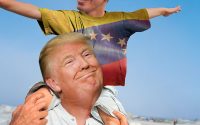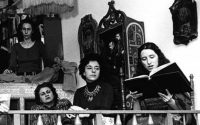Guinea-Bissau // The Commandos and their crimes~ 6 min

By Nguyen
Ethnic divisions and their role in Guinea-Bissau’s liberation war
Divergente recently published a report giving voice to the black commandos who fought for the Estado Novo during the war of liberation in Guinea-Bissau. Since it is an underreported topic of historical interest, it is aberrant that they chose the path of presenting a military force made up of war criminals as if they are poor abandoned miserables. In this, they are replicating, to some extent, the discourse that the far right has been spreading.
In the report they do not mention, due to lack of knowledge or unwillingness, the ethnic composition of the forces. Something that the Estado Novo regime was well aware of and used to its advantage, recruiting African forces based on ethnic tensions between ethnic groups and rebellious sectors. Hence, it recruited more Manjacs, Fulas and Felupes in Guinea-Bissau than from other ethnic groups. The exploitation of ethnic tensions and the use of commando-type special forces is common in all three liberation wars in Angola, Mozambique and Guinea-Bissau. The participation of black troops increases with the unfolding of the wars. They are present in militias, armed village protection groups, the armed forces in general, and special forces.
Creating the Commandos force
With the outbreak of war in Angola, Portuguese forces are caught off guard and it is necessary to recruit and mobilize troops. These forces are formed and created to fight a counterinsurgency war and, as such, it is necessary to innovate, as the existing forces were created and trained to fight in the context of NATO – in a possible confrontation with the Warsaw Pact. Broadly speaking, the Portuguese strategy is split between the defense and/or creation of strong points, “stings” (actions to search and destroy mines and other explosives) and attacks against the bases of the guerrilla forces.
It is in this context that the Commandos were created in 1961, becoming operational in 1962 in Angola. Similar forces are also formed inside the armed forces, such as the Special Groups and Special Paratrooper Groups (in Mozambique) and the Flechas [Arrows] (which belong to the PIDE/DGS [secret police] structures). Also noteworthy is the use, in Angola, of exiled and/or mercenary troops from regimes close to the Estado Novo – such as the Leais Zambianos [Loyal Zambians] and the Fiéis Catangueses [Faithful Katanguese].
The Italian fascist who participated in the creation of the Commandos
The Commandos were created by the Portuguese military and an obscure figure called Dante Vacchi. According to the facelifted version presented by Portuguese journalism, he was a journalist and “Italian adventurer” who had been part of the French Foreign Legion and had combat experience. Through a succession of coincidences, he travels from Portugal to Angola and becomes an instructor during the creation of an elite troop, open only to volunteers.
The reality is much more sinister than what this sequence of “unforeseen” events presents. Dante Vacchi fought alongside the Nazi troops that invaded Italy, with the aim of reinstating Mussolini in power and taking over the north of the country. Post-war he joined the Foreign Legion and fought in Algeria and Indochina. He may have come into contact with either members of the OAS (Organisation Armée Secret, a group of racist and pro-colonialist supporters of the Vichy collaborationist regime), or with the network created by Otto Skorzeny (former commander of the Waffen SS who fought in Italy) which operated in the Iberian Peninsula and will eventually form Aginter Press.
Aginter was based in Lisbon and formed by Yves Guerin-Serac in 1963. Officially it functioned as a press group, but in reality it was a network of fascist and Nazi mercenaries who provided espionage, information, training and counterinsurgency services, issuing journalist credentials to move their agents more easily.
The role of the Commandos will be to attack villages suspected of harboring guerrillas, to identify bases of liberation movements, to gather information and prisoners and to attempt to assassinate key elements of the liberation forces.
The Commandos’ war crimes
Unfortunately, during the wars of liberation in Portuguese-speaking African countries, the Commandos are known to have committed numerous war crimes and violations of the Geneva Convention. In the famous documentary A Guerra [The War], reports from elements of the liberation forces, civilians and the Portuguese forces themselves confirm their occurrence.
Murdering civilians (including women and children), burning homes, looting and destroying people’s livelihoods, and even wearing the uniforms and insignia of opposing forces are recurrent episodes and part of commando instruction. The raping of women, torture and murder of prisoners of war and dismemberments are also crimes attributable to this force.
The most reported crimes are possibly those that occurred in Mozambique, where the populations of Wiriamu and Mucumbura were slaughtered with refined sadism by the Commandos. According to descriptions, there is a concern with eliminating all witnesses and reports, a kind of standard procedure, which aims to safeguard the image of the various special forces that operated in the wars. It is difficult to believe that these massacres were exceptional and anomalous situations.
While not exactly war crimes, the Portuguese attacks on Guinea Conakry and Senegal, carried out by commando forces, are at least questionable. Especially operation Maré Verde [Green Tide], which has as one of its main objectives the overthrow of Sékou Touré’s government and the installation of a puppet government favorable to Portugal, as well as to attack the structures and civilian members of the PAIGC (which actually is a war crime).
The Royal Amethyst operation took place on the other side of the border. Senegal, another nation at peace with Portugal, was invaded. The attacks are carried out by the Commandos. The UN condemns Portugal’s actions and wars against countries and peoples who are in their legitimate right of self-determination and independence.
The infamous Marcelino da Mata
If we are discussing Commandos, we cannot fail to mention one of their founders, the infamous Marcelino da Mata. A beast that boasted of killing prisoners of war and cutting off their genitals. The fact that this underling of the Estado Novo had members of the armed forces and the State present at his funeral, and that he kept the “medals” that were awarded to him, shows that something is deeply wrong. Not least because this individual’s crimes against the III Portuguese Republic did not cease with the end of the war.
Marcelino was a member of the MIRN – a far-right terrorist network that plagued Portugal. He would continue his political participation in the Portuguese far right for the rest of his life. Obviously, all those nostalgic for the Estado Novo wanted to pay homage to the war criminal, using the key expression of the fascist-sphere, “a controversial character”, to rehabilitate him and his cronies.




